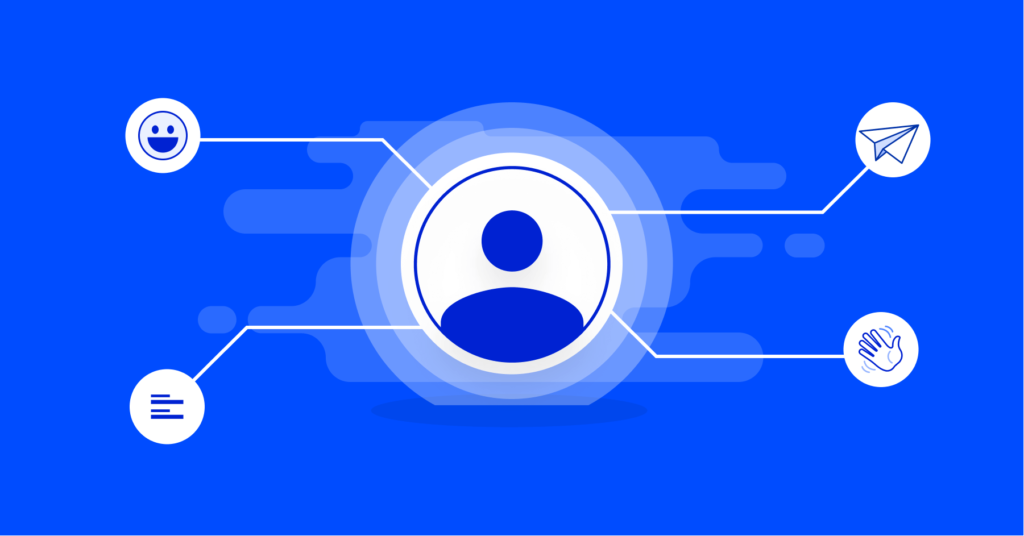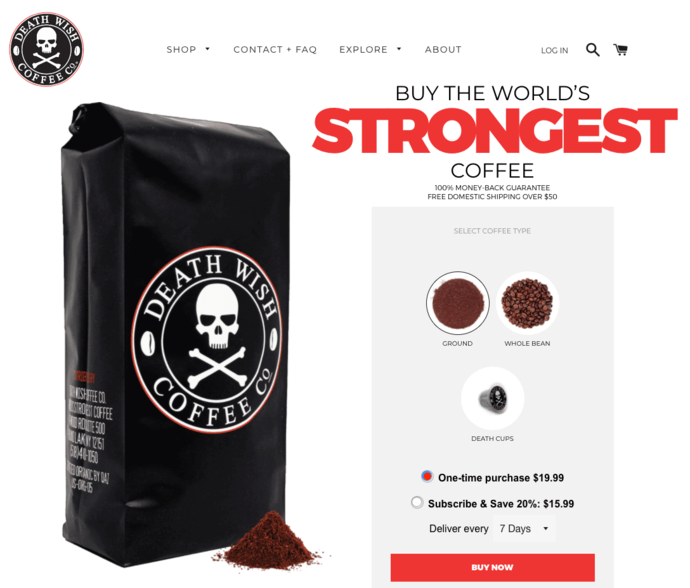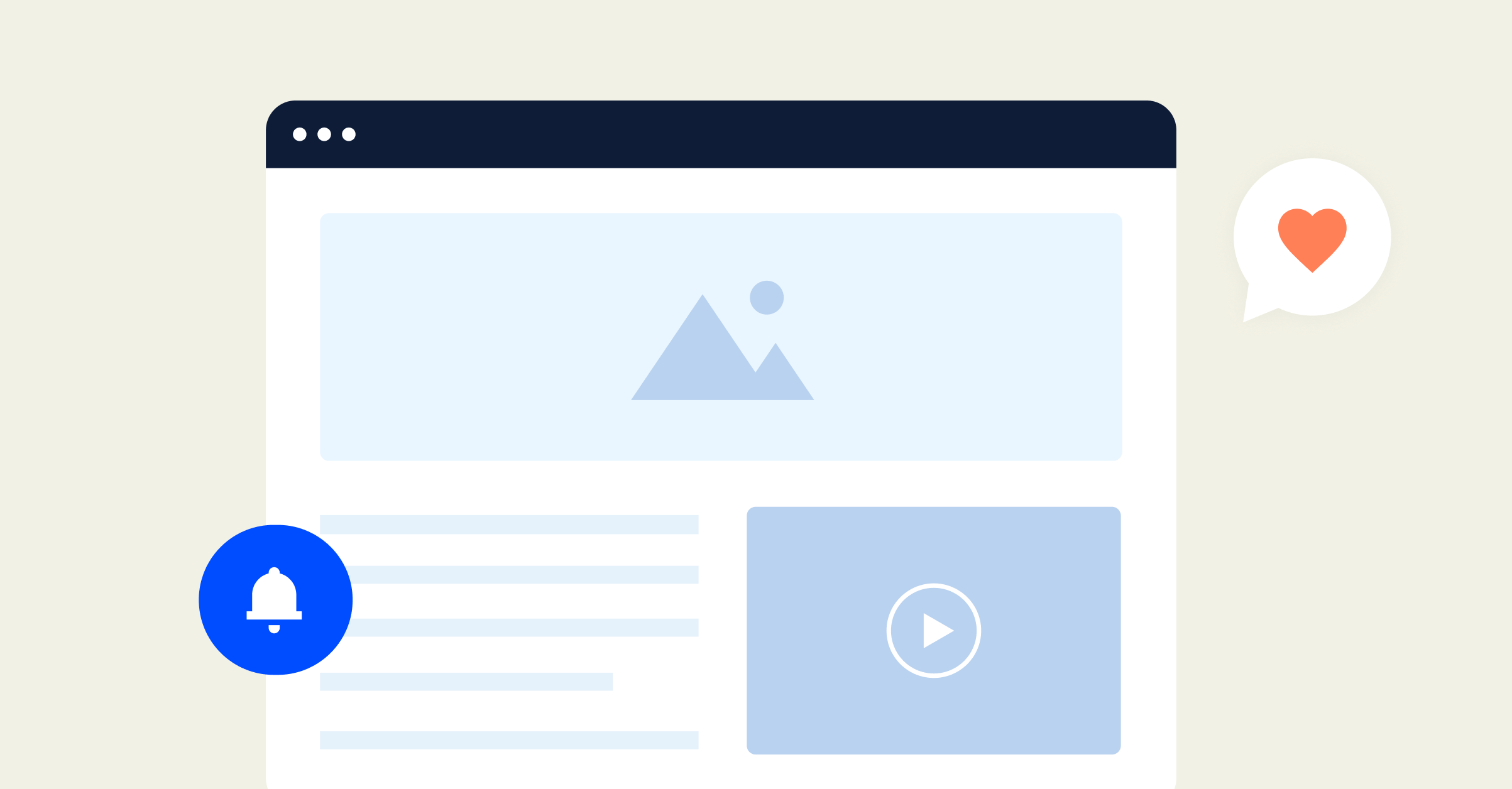Loyalty marketing has a long history, with the first loyalty program dating all the way back to the 1850s.
However, this is far from an outdated practice. In fact, loyalty marketing has arguably become more important than ever. Companies recognize how critical customer retention strategies are, particularly as new competitors enter the market.
This said, the loyalty marketing tactics used over 170 years ago probably aren’t going to cut it, and ambitious companies will need to take innovative steps to keep customers paying.
This article will discuss why loyalty marketing is so crucial in today’s environment, highlight four tactics you can use to push down churn and drive your recurring revenue up, and discuss what content you can create to build customer loyalty.
And heads up: This post is part of our Content Creator series that delves into essential strategies that empower content creators – from those working independently to those creating content for large organizations and everyone in between. Discover all of the resources below.
Content Creator Resources
What is a Content Creator and How to Become One
How to Market Yourself as a Content Creator (8 Steps For a Head Start)
CRM for Creators: How Content Creators Benefit
CRM Customer Engagement: Using Behavioral Data to Boost Engagement
The 8 Best Content Marketing Platforms
Email Marketing for Content Creators: How Creators Can Build an Audience with Email
Content Creator Newsletter: How to Write an Engaging Newsletter in 4 Steps
How Predictive Analytics is Revolutionizing Content Creation
The Power of Audience Segmentation for Content Creators
Unlocking Engagement: A Guide to Personalized Content Creation
Revolutionizing Content Creation: The Power of Automated Marketing Campaigns
Navigating the Frontier of AI Content Creation: Tools, Techniques, and Trends
7 Conversion Rate Optimization Techniques That Boost Conversions
4 Loyalty Marketing Tactics and the Content That Drives Engagement
The 14 Best Newsletters for Content Creators: The Ones Worth Subscribing To
What is loyalty marketing?
Loyalty marketing is a strategy designed to retain customers and increase recommendations through various tactics such as discount codes, special offers, gifts (including gift cards), and referral and rewards programs.
Here’s how it works. Let’s say you’re an online retailer of cosmetics (loyalty marketing is most frequently used by sellers of physical products). Your primary pathway for acquisition right now is through paid advertising on social media platforms. Customers view your ads, click through to your site, and make a purchase.
You know (perhaps through a series of surveys or customer interviews) that the customers you serve also shop with a number of competitors, and you’d like to increase your share of wallet (the amount of in-sector spending your company receives).
So, you cook up a series of loyalty strategies:
- A 20% discount code sent to each customer one week after their first purchase (designed to encourage a second purchase)
- A rewards program where buyers receive $1 back for every $50 they spend online
- A referral program where customers receive a $20 voucher for every new customer they refer
Loyalty marketing can be a whole lot simpler than this, too. Even the ubiquitous coffee card (where you collect ten stamps and get your next coffee free) is a form of loyalty marketing. And loyalty marketing isn’t just direct to the customer, you’re able to grow your audience (and revenue) by means engaging customers through incentives that motivate existing customers to recommend your brand to their friends.
According to our coupons report, 91% of consumers are willing to recommend an online store to family and friends in exchange for a coupon good for their next purchase.
In the long run, incentives may drive more ROI than paid advertising. Download our report for free to see how strategic incentives like coupons and buy one get one (BOGO) offers can significantly influence customer decisions and foster brand loyalty.
Why does loyalty marketing matter to today’s companies?
There’s a fairly obvious answer here: you want to keep your valuable customers coming back.
While this is true, there are a couple of more nuanced arguments that make a case for loyalty marketing programs in a modern context.
It’s often more cost-effective to retain than acquire
There’s an old saying floating around in the business world: It costs 5x more to acquire a new customer than to retain a current one.
The exact figure will depend quite heavily on factors specific to your company (your average purchase amount, industry, customer acquisition cost, particular retention tactics you employ, etc.). But you can be confident that a dollar invested in customer loyalty and retention will be more valuable to the bottom line than if invested in acquisition.
A big part of this is that it’s simply easier to sell to an existing customer than to a new prospect (by as much as 12x).
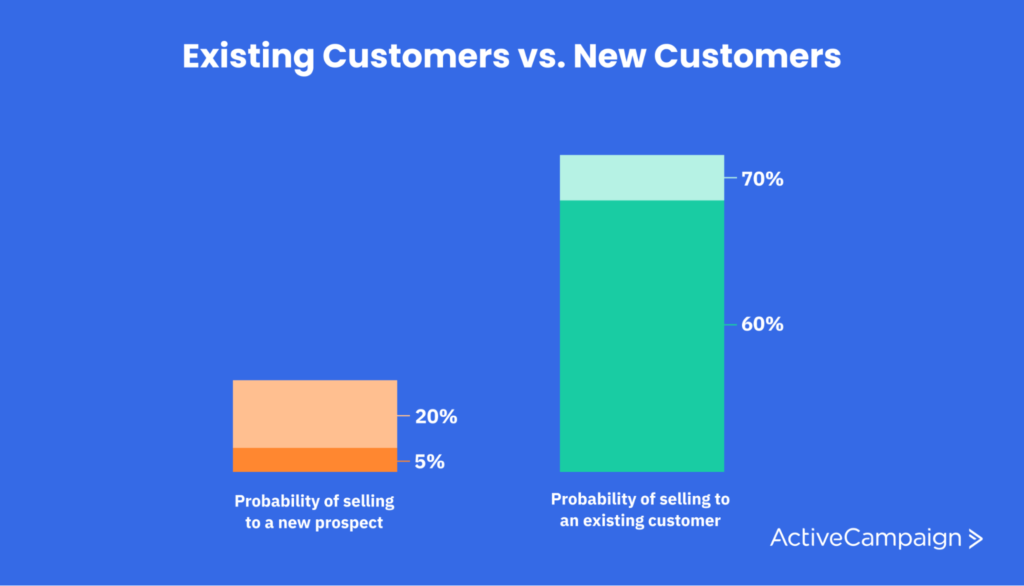
You’ve already gotten past the brand-trust barrier when you’re selling to an existing customer. They know who you are, they’ve bought from you before, and they trust you to deliver the value you promise in your marketing messaging.
So, they’re more likely to buy from you than a first-time buyer.
Retention is the foundation of growth
Consider how much time, money, and effort you put into developing content, social media presences, and inbound marketing funnels. With this level of investment, you don’t want the outcome to be a single purchase—you want that customer for life.
Consider this simple example:
You have a customer acquisition cost of $20 and an average order value of $60.
If each new customer you attract buys from your company just once, you have an ROI of 200%. If the average customer purchases from you five times (because your loyalty marketing initiatives are so strong), you up that ROI to 1,000%.
Loyal customers drive more referrals and spend more
Loyal customers are simply better for business.
First of all, nearly 40% of them will spend more with your company, even if a competitor offers a cheaper option.
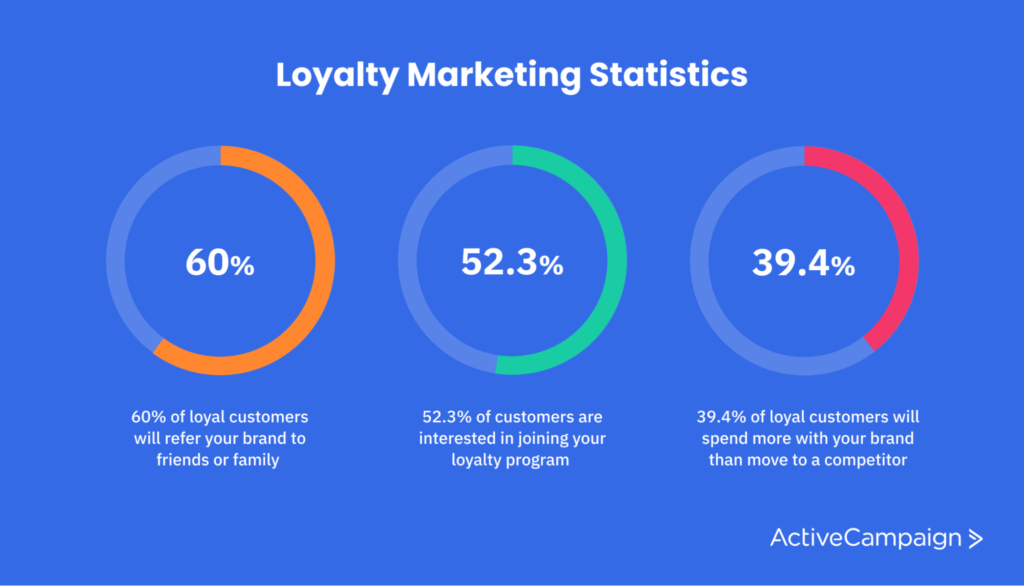
This means that their loyalty to your brand (and your loyalty to your customers) means more to shoppers than price point alone.
Secondly, 60% of loyal customers will recommend your company to friends and family.
That’s where the real win is. If you’re successful at turning buyers into regular customers, you’re essentially building a sales army that’s out there telling other people just how great you are. This drives new revenue on your behalf.
Customer loyalty programs offer a powerful data capture method
Getting customers to engage in loyalty programs allows you to capture more insightful data on user behavior, improving your understanding of what makes an ideal customer.
For example, you might identify that while your e-commerce cosmetics brand serves women between 18 and 65 years old, the segment aged between 20 and 30 is the most loyal, refers more new customers, and shops more often. You can then leverage this insight to pivot your marketing strategy and target an audience that fits this demographic.
4 examples of successful loyalty programs
Before diving into any loyalty marketing strategies or tactics, it’s crucial to define what we mean by a “loyal customer.” Not all customers will necessarily become loyal customers, so this process will help determine exactly who we’re targeting.
Shep Hyken, a speaker and thought leader on customer service, divides customers into six categories:
- Satisfied customers. These customers purchase from you, but they don’t exactly love your brand. They’re satisfied, but they’re likely to be swayed by a decent offer from a competitor.
- Program-loyal customers. These customers buy regularly, but only because of the loyalty program you offer and not because they have a deep sense of affiliation with your brand or product.
- Convenience-driven customers. These customers buy from you because you’re the most convenient option and would likely switch if a more convenient competitor presented itself.
- Ease-of-staying customers. These customers appear loyal but only continue to buy from you because it’s too hard to switch to a competitor (typical in the banking and consumer power sectors).
- Price-loyal customers. These customers keep buying from you only because your prices are lower than competitors. You’re at risk of being undercut, as you’ll lose these customers to a more cost-friendly brand.
- Brand-loyal customers. These are the customers who are genuinely loyal to your brand, regardless of price, convenience, or any other factor. They’ll become your advocates, and they’ll likely never think of moving away from you. Think Apple/iPhone fans.
Which of these customers will you be targeting? Though brand-loyal customers are, for the most part, ideal, even program-loyal and price-loyal customers still drive the bottom line, so they are also a reasonable initial target.
Identify what categories your audience falls into by running customer surveys or interviews. Keep channels open for feedback on social media, your website, and email. Use email surveys to ask specific questions designed to uncover why your current customers purchase more than once.
Then, take note of these four case studies to employ in your own customer loyalty marketing strategy.
1. SweetLegs’ rewards program
Rewards programs are among the oldest and surest tactics in the loyalty marketing playbook.
There are a couple of ways to run one. The simplest is a cashback scheme, similar to how a credit card works. For example, for every $100 your customer spends in-store or line, they receive $5 on their rewards account.
Alternatively, you can use a points system.
SweetLegs, an online retailer of women’s pattern leggings, is an excellent example of this approach done right.
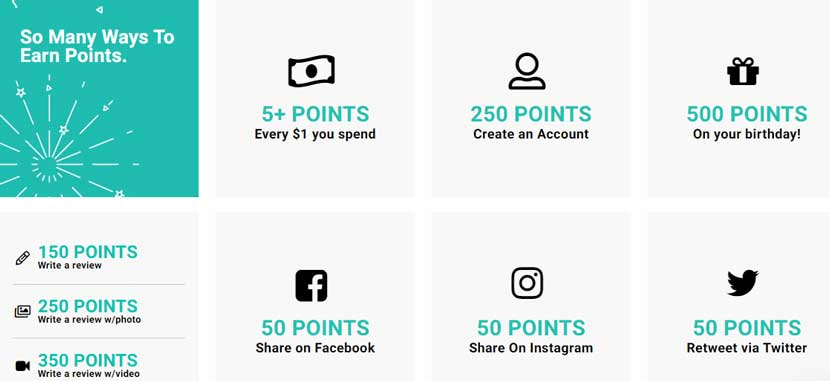
SweetLegs rewards customers with five points for every dollar they spend in its online store. However, they also incentivize activities such as leaving reviews and social media shares (both helpful for further SweetLegs’ reach) with reward points.
Customers can then redeem their points for discounts at the checkout.
2. frank body’s customer shout-outs
Customer loyalty is built on trust, and trust runs both ways. Show your customers you care about them and value their brand loyalty by shouting them out on social media. Cruelty-free skincare brand frank body regularly posts user-generated content on its Instagram page.
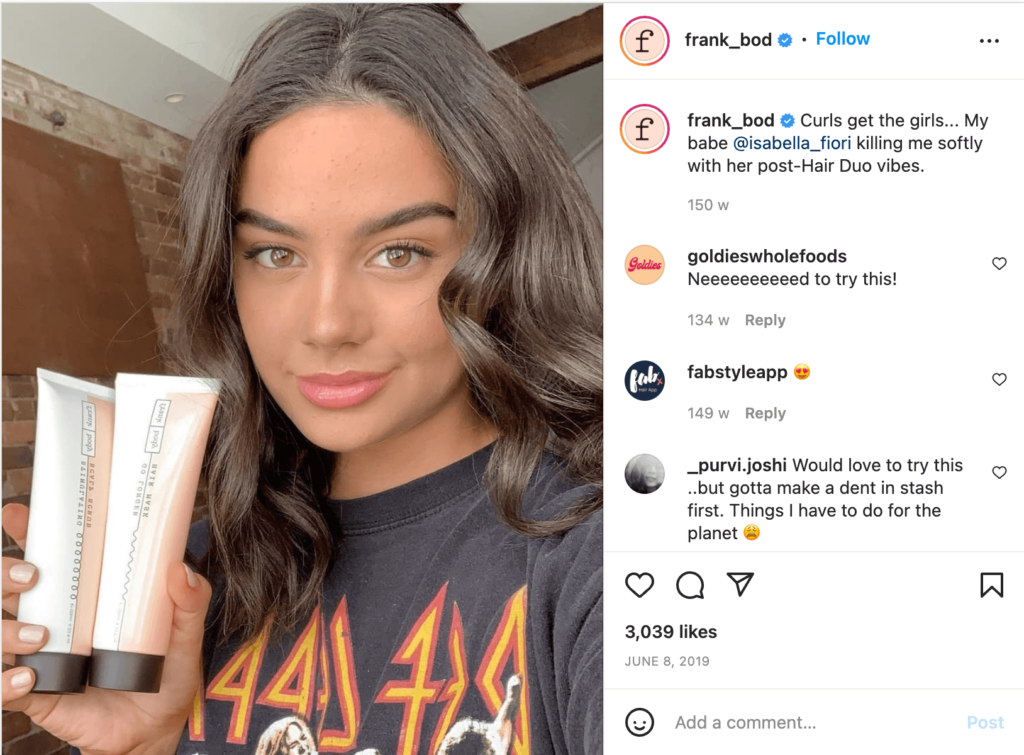
This type of customer loyalty program kills three birds with one stone:
- Showing customers the brand cares
- Leveraging the audience of the user it’s shouting out
- Demonstrating its product in action on real-life users
You can find other ways to celebrate your customers by incentivizing video testimonials and reviews or sending out free gifts on their birthdays.
3. BlackMilk Clothing’s exceptional customer service
Perhaps the number one way to encourage loyalty and retention is to continuously strive to meet customer service expectations.
Today’s customers expect responses quickly, regardless of the channel they’ve used (email, phone, social media, ticket logs, chatbots, etc.), and they expect competence in solving the problem at hand. BlackMilk Clothing‘s Twitter team shows us just how important it is to respond quickly, professionally, and usefully.
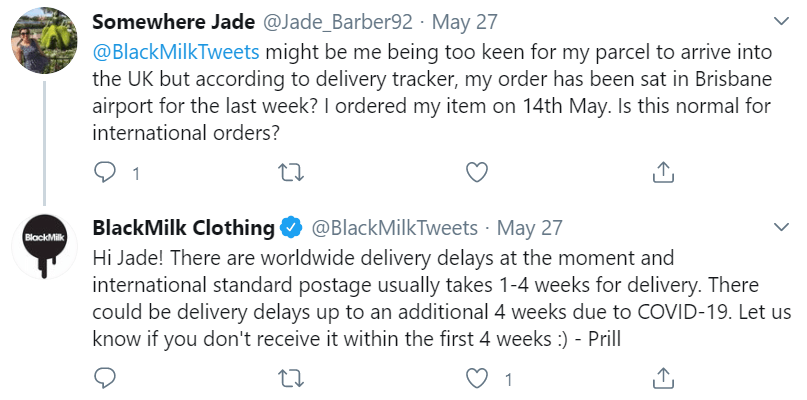
Here’s what BlackMilk did right:
- The brand responded to its customer’s Tweet on the same day
- The person responding outlined the reason for the delay rather than dancing around the question or making excuses
- They invited the customer to stay in contact, making them feel like BlackMilk cares about their business
- They left a human name on the response
4. ClassPass’ powerful referral program
Referral programs are powerful tactics because they achieve two goals at once.
First, they help you understand how loyal your customers are (those who don’t believe in your brand are unlikely to recommend it). Secondly, they help you reach new audiences and grow your loyal customer base.
It goes without saying that your referral offer needs to be compelling enough to motivate users to recommend your brand. But effective referral programs go a step further and extend an offer to the referee as well.
Take ClassPass, a fitness class and salon booking app.
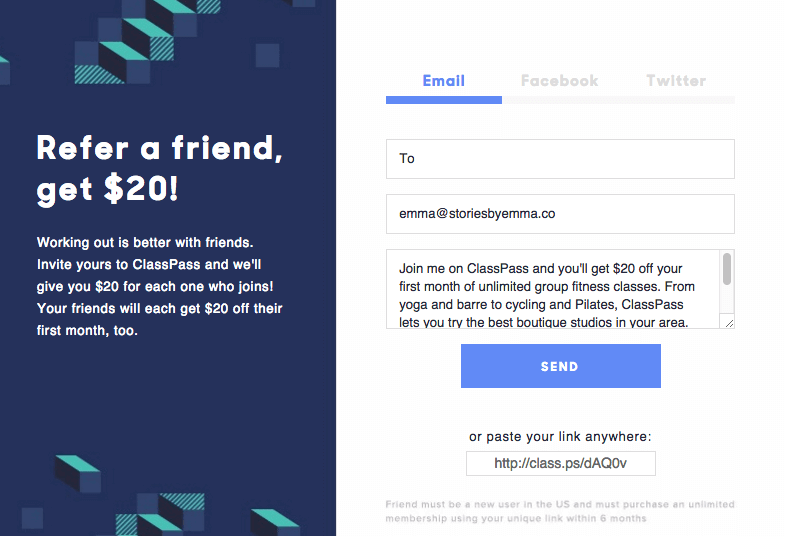
Its referral offer gives customers $20 in credit for every friend they successfully refer. They also offer $20 off the first month of classes to the person they refer.
Getting customers to refer can be simple. However, motivating the people they referred to actually buy is another thing! Extending the offer to both parties is an excellent tactic for fostering this result.
Creating engaging content that builds loyalty
There are many different ways you can create content that will improve customer engagement and boost brand loyalty. Folding common content marketing tactics into your loyalty marketing can strengthen your relationship with your customers and prove yourself as a brand people can trust.
Here are four tactics you can use to do just that.
Showcase customer testimonials
Featuring customer testimonials is a powerful method to boost brand loyalty for several reasons.
Firstly, these testimonials add credibility and authenticity to a brand’s image. When potential customers see positive feedback from satisfied customers, it builds trust in the brand and its offerings. Testimonials act as real-life endorsements, confirming a brand’s claims and providing social proof of its value.
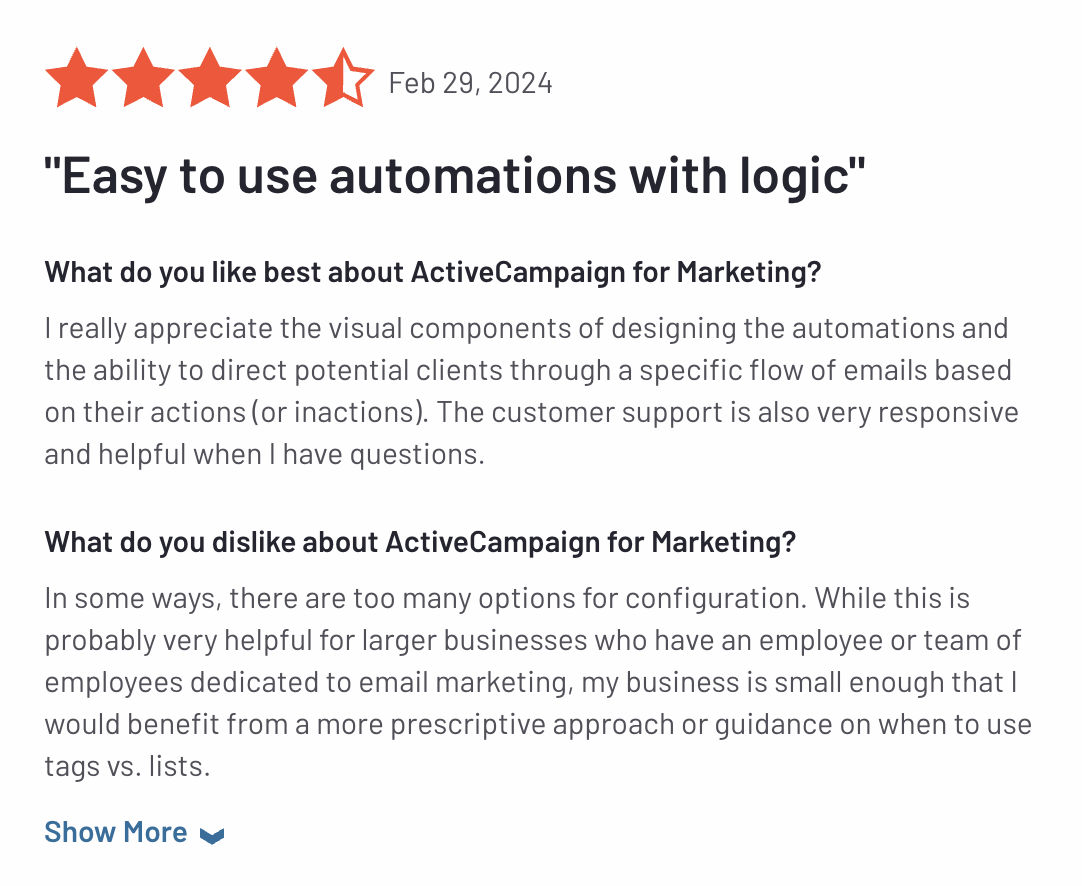
On top of this, they humanize a brand by sharing genuine experiences and emotional connections that resonate with prospective buyers. By showcasing the positive experiences of existing customers, businesses can create a sense of community and belonging, fostering long-term relationships based on trust and satisfaction.
Encourage user-generated content (UGC)
Employing user-generated content (UGC) is another tactic for driving brand loyalty for several compelling reasons.
UGC lends an authentic and relatable voice to the brand, as it comes directly from the experiences and perspectives of satisfied customers. By allowing customers to speak as the brand voice, businesses can tap into the genuine emotions, stories, and testimonials of their audience, fostering a deeper sense of connection and trust.
UGC also serves as a powerful form of social proof, demonstrating to potential customers the real-world value and satisfaction associated with the brand. When customers see their peers endorsing and engaging with a brand, it enhances credibility and encourages them to join the community.
Experiment with interactive content
By experimenting with quizzes, polls, contests, and interactive videos in marketing strategies, brands can engage customers in meaningful ways, encouraging active participation and fostering a sense of ownership. Interactive content not only captivates audiences but also provides valuable insights into customer preferences and behavior, enabling brands to tailor their offerings and messaging accordingly.
Send valuable, personalized content
Value should be at the very top of your mind when creating any form of content.
While creating content that is attention-grabbing and intriguing may help you increase interest in your brand, you will find that spending your time creating content that solves a problem or provides value immediately will make more of an impact on a customer’s lifetime.
Your content should be highly valuable and highly sharable. You want to engage your prospects and existing customers with content that is useful to them and works to solve a problem so they see you as a source of knowledge. The key here is to personalize your content and ensure you’re segmenting your audience into groups so each customer receives content that is relevant to them.
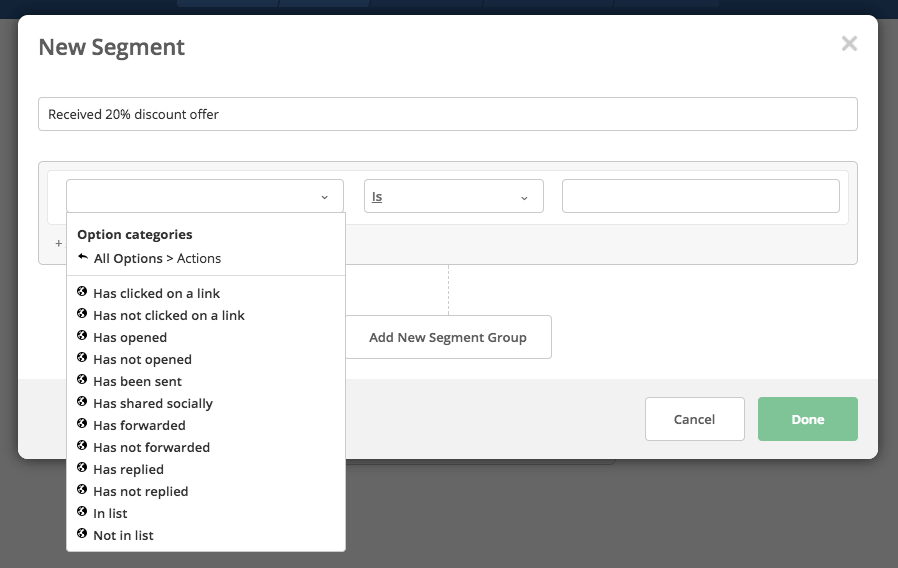
Keeping these four tactics in mind as you create different types of content will be the key in building a great loyalty marketing program.
Invest in customer loyalty marketing
Though loyalty marketing has been around for years, it’s far from an irrelevant or outdated practice.
In fact, creating loyal, long-term customers is more important than ever. Businesses with solid retention programs will see higher customer lifetime values and greater rates of customer referrals. They will also be better able to withstand market assaults from new competitors, particularly where they pertain to pricing.
To run a successful loyalty marketing program, it’s imperative that your company communicates regularly and effectively with your audience.
You’ll need to conduct customer satisfaction surveys, schedule social media posts, monitor feedback channels, and send out regular updates on rewards statuses. Check out ActiveCampaign’s suite of marketing automation tools, and discover how our intuitive platform can help you put these tasks on repeat.
If you’d like to give us a try, sign up for a free trial today.
Next read: The 13 Best Newsletters for Content Creators: The Ones Worth Subscribing To
